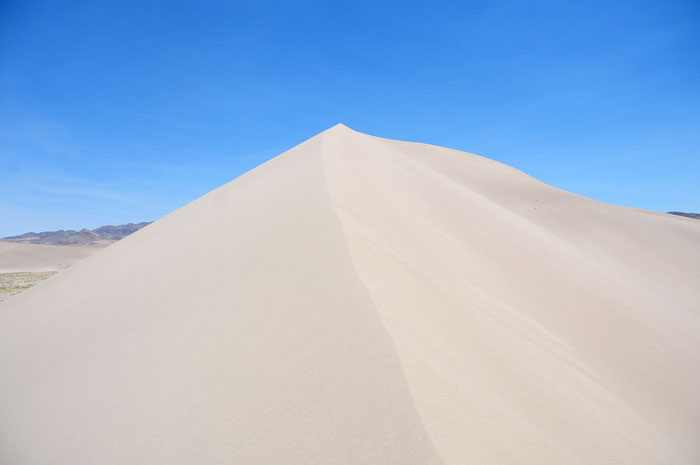NV Energy Terminates Power Purchase Agreement for Crescent Dunes Solar Power Tower
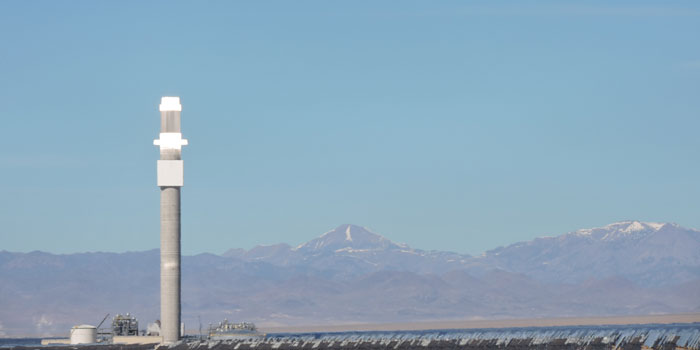
October 6, 2019 - Tonopah NV - The utility NV Energy, we discovered, had given a 6 month notice to the Crescent Dunes Solar Energy Project in January 2019, for failure to supply the power generation agreed to. Several news sources reported that NV Energy has terminated the contract to buy power from the troubled solar project.
Basin and Range Watch has been following this power tower from the beginning, visiting the site before it was built, and commenting on the envieonmental impacts the project had. We even won a Freedom of Information Act lawsuit againts the local Bureau of Land Management file office for failure to produce videos showing birds singed and pyrolizing in the solar flux.
The solar power tower has been offline for months at a time lately, as we drive by and look. Rumors abound about the breaks and and leaks in pipes and the super-heated molten salt tanks.
This is a setback for utility-scale storage technologies that would help balance the grid due to overgeneration of solar energy during peak times. Another reason we support advanced Distributed Energy Resources in the build environment.
Bloomberg reported that the Department of Energy (DOE) may be trying to take over the solar power plant. Solar Reserev received a generous $730 million loan guanantee. We predict this solar power tower will be taken over by DOE and used as some sort of experimental renewable energy plant in the future.
Plenty of Birds Around Crescent Dunes Solar Power Tower
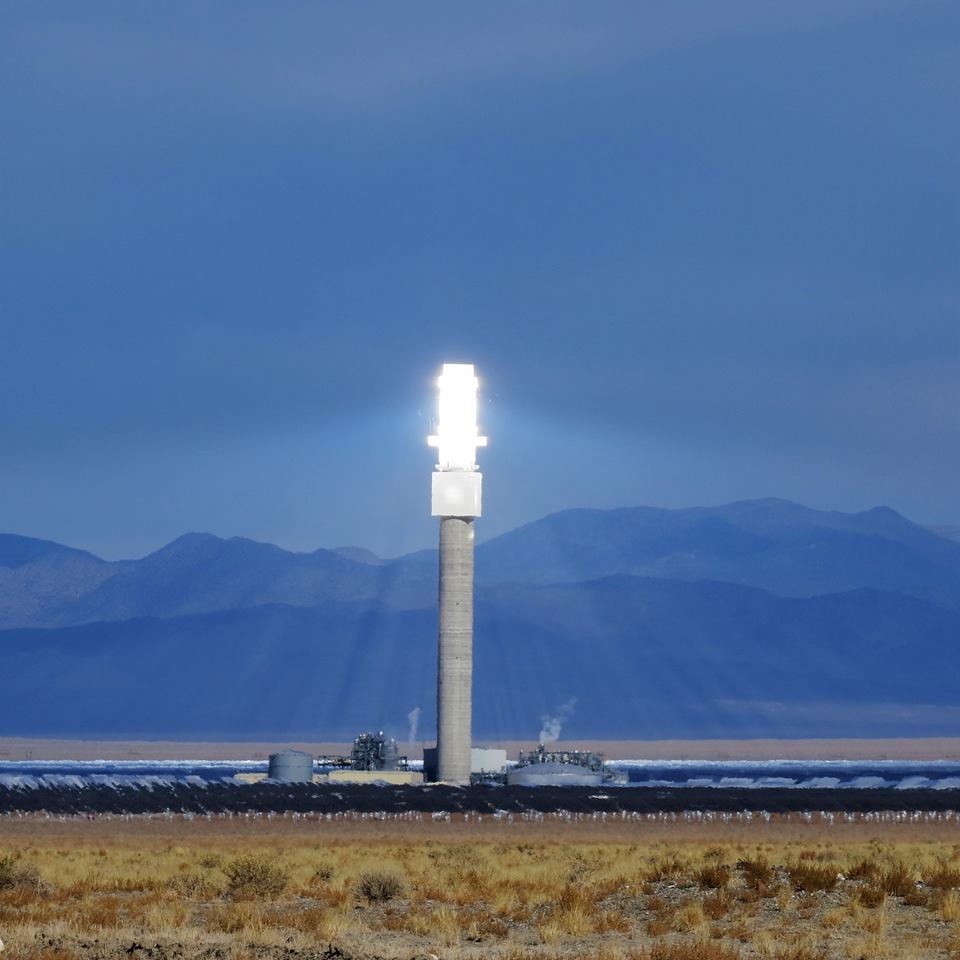
^The solar flux generated from the receiver tower by thousands of heliostats concentrating sunlight.
November 3, 2017 - Tonopah NV - The solar flux seen today from the Crescent Dunes Solar Energy Project was in evidence on the morning of October 30, 2017, although clouds shut the facility down for the afternoon. We hiked around the proposed project site of the massive Sandstone Solar Project--ten more power towers--and noted the diversity and numbers of birds in the area.
We saw over 100 horned larks, a Northern harrier, juvenile red-tailed hawk, a Western meadowlark, a few ravens, and more birds around the solar plant's evaporation ponds: 70 ducks flying around, pintails and possibly buffleheads, as well as 40 gulls, including California gulls and ring-billed gulls.
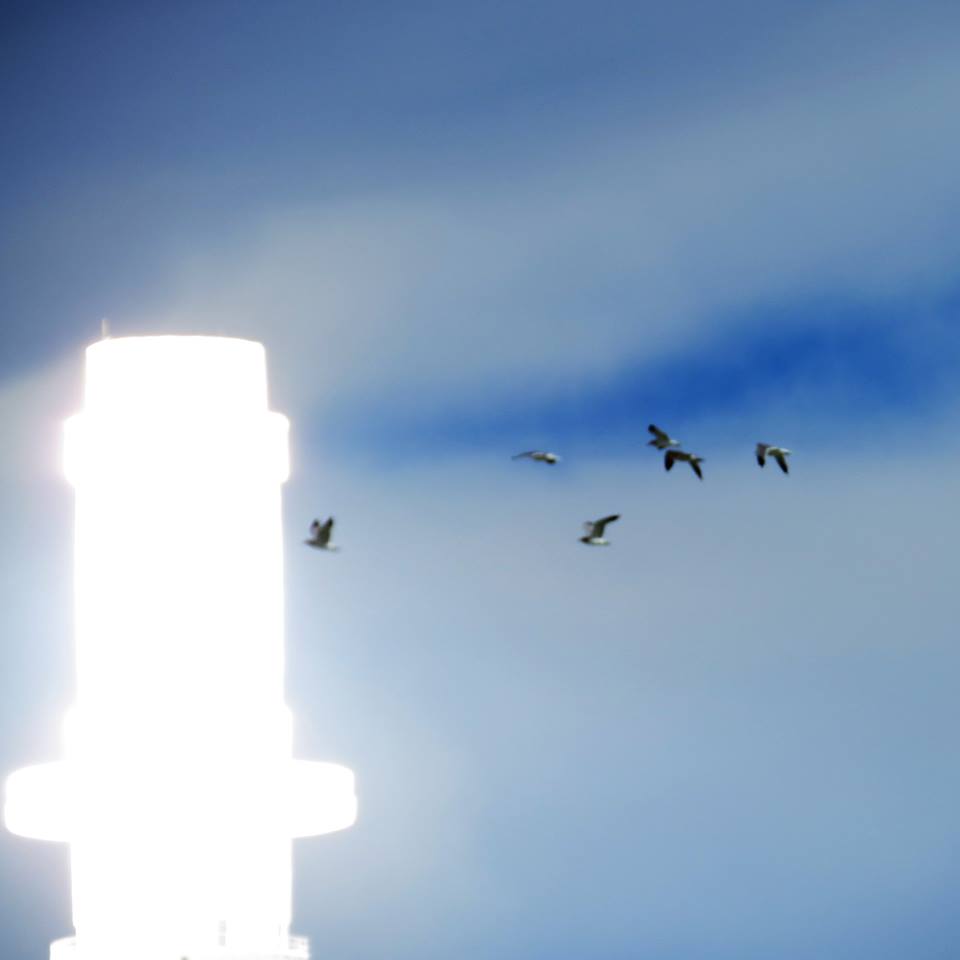
^California and ring-billed gulls near the solar tower at the project's 30 acres of evaporation ponds.
Solar flux is intense electromagnetic radiation generated from concentrated solar energy. Heat energy contacts organic matter and breaks down tissue.
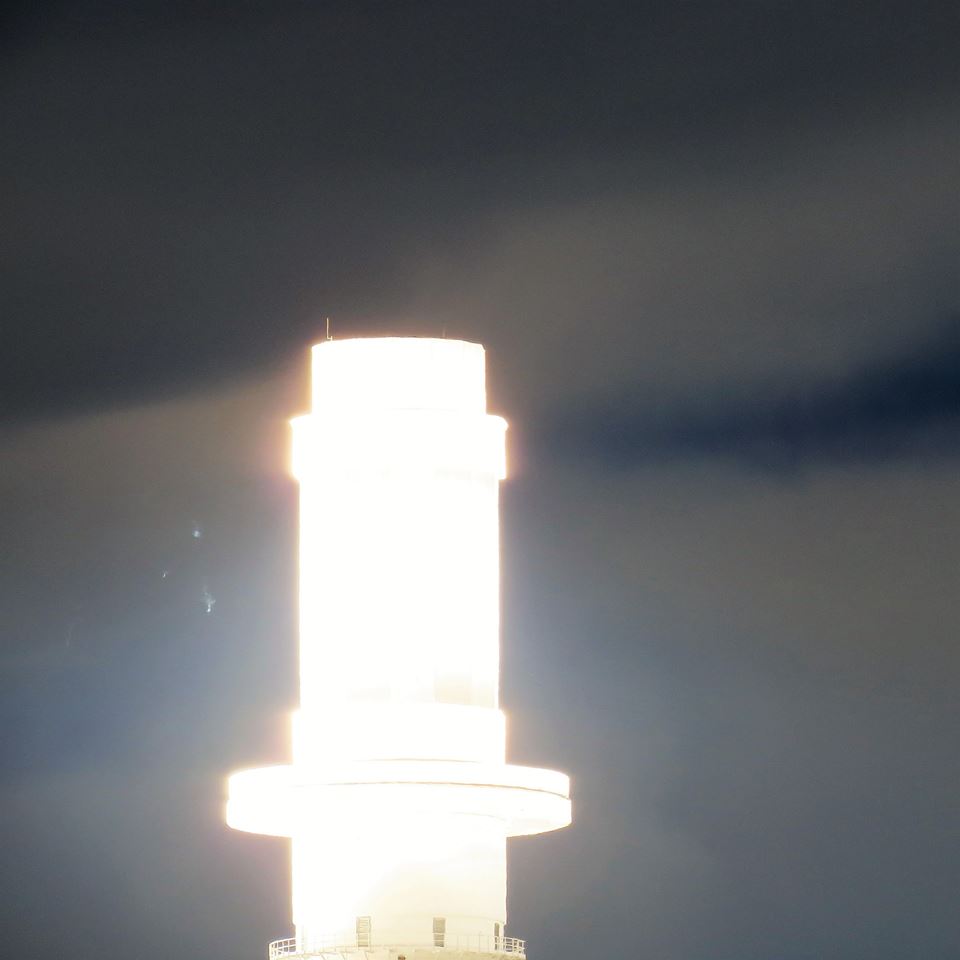
^"Streamers" - small birds, possible horned larks, vaporizing or pyrolizing in the solar flux. Seen at 11 a.m. (The streamers are the small smoke-like puffs on the left side of the tower.)
See the article in the Pahrump Valley Times by Daria Sokolova: Glare from proposed Nye solar project raises concerns.
Crescent Dunes Solar Thermal Tower: Leaks and Safety Hazards, Yet SolarReserve Wants to Build Ten More
September 29, 2017 - Tonopah NV - On September 5, we attended a meeting of the Nye County Commissioners in Tonoaph, which was also videocast in Pahrump. The CEO of SolarReserve, Kevin Smith, gave a talk in person about his ideas to construct and operate a larger series of solar power towers near the original power plant at Crescent Dunes. The new project is just in the idea stages and does not have a Power Purchase Agreement, or financing, and no environmental review has publically begun.
The Sandstone Solar Energy Project would entail building up to 10 more solar power towers, each with molten salt storage, and up to 2,000 megawatts of energy generation.
Yet problems have plagued the Crescent Dunes solar power tower, with apparent weld problems in the pipes, and a leaking molten salt tanks that caused skin irritation and breathing issues with employees recently (see the article by Daria Sokolova in the Pahrump Valley Times). Nitrous oxide gas is a hazardous byproduct of molten salt, which is made of sodium nitrate and potassium nitrate, and releases need ventilation or hazards to workers may result.
Crescent Dunes Solar Power Tower Back Online After 8 Month Repairs
July 30, 2017 - Tonopah NV - We noticed that the glowing sun-like light was brilliantly glowing again atop the 700-foot power tower out in the remote desert of central Nevada. Solar Reserve finally flipped the switch back on to their utlity-scale solar thermal power plant, which has molten salt tanks to store excess electricity generated after dark. Sources tell us the intense heat of this solar power plant--at a scale never attempted before--presented problems for pipes and welds. Vibrations of molten salt flowing through the pipes caused problems.
We have concerns with this type of technology due to the intense heat-energy created by sunlight bouncing off mirrors and concentrating at the tower receiver (where the molten salt is heated): the solar flux incinerates or injures birds which fly through it. Right now, swallows are flying about the desert in post-breeding movements. Other birds may also be active, such as lesser nighthawks. We will be monitoring the mortality reports since this power plant is on public land.
Also see the article in the Las Vegas Review-Journal.
Crescent Dunes Solar Power Tower Still Offline
February 4, 2017 - Ramping up is taking a lot longer than expected for the Crescent Dunes Solar Energy Project near Tonopah NV, as a small leak in the hot salt tank was found in December 2016. The power plant is still off a few months later. The molten salt tanks are used for thermal storage. The unprecedented size of the plant might account for the difficulties in the construction of the pipes, welds, and other parts with the extreme heat of the molten salt as it is heated by the sun in the receiver tower, and flows down into the storage tanks.
See http://pvtimes.com/tonopah/salt-leak-shuts-down-crescent-dunes-solar-plant-outside-tonopah
Basin & Range Watch Sues Bureau of Land Management for Withholding Bird Mortality Information
September 1, 2016 - Update: article in EENEWS http://www.eenews.net/stories/1060042210
February 29, 2016 - Basin and Range Watch filed suit last Friday under the Freedom of Information Act (FOIA) to obtain documents that the Bureau of Land Management (BLM) has refused to disclose about bird mortality during a testing phase for the Crescent Dunes Solar Project, a concentrated solar energy power tower located just north of Tonopah, Nevada, which went on line this month. Basin and Range Watch supports renewable energy, but also seeks transparency in government and an open public dialog about solar project impacts on public land that receive public funds.
See more >>here.
Operational Solar Flux
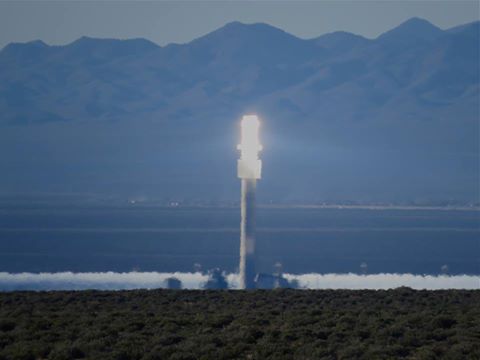
April 2, 2016 - This photo was taken yesterday around 5:30 pm as the Crescent Dunes solar power tower appeared to be in full operational mode, creating a very bright solar flux as concentrated sunlight was aimed by thousands of mirrors at the central receiver on top of the tower to heat molten salt.
Seen here is the glowing power tower (visible for miles) and if you look carefully at the photo, you can see the cone shaped "solar flux" generated by mirrors surrounding the tower, radiating out thousands of feet. Temperatures can be from over 1,000 degrees to 400 degrees F.
The owner, Solar Reserve has made multiple press releases suggesting that they have fully mitigated the problem of solar flux bird incineration by alligning the heliostats (reflector mirrors) is a safe mode during stand by (when the mirrors are not focused on the receiver tower). The problem is that this project relies on molten salt thermal storage to produce heat after hours. In order to keep the salt hot for the longest period after sunset, they must really focus the heat on the tower. This photo was taken at 5:30 p.m. It is very difficult to accept their claim that the project does not kill birds after the January 15th incident that vaporized 130 birds in 4 hours. The project is on public land and was funded in part by a $733 million Department of Energy loan guarantee. They have not mitigated operational solar heat flux and flux is always visible when it is in stand by.
Solar Reserve responds via Facebook (April 4):
SolarReserve Basin & Range Watch: Your information is incorrect. As you know, there are several teams of independent third-party environmental scientists who have been closely monitoring the site at all times for 2 years now. Their studies have proven that Crescent Dunes is one of the safest forms of electricity generation, especially for bird safety, with an average of LESS THAN FIVE bird fatalities per month at the facility.
Of note, we have provided detailed information to Basin & Range on bird monitoring and solar flux in earlier Facebook posts, which you have deleted. The BLM has confirmed the mortality numbers that the third party environmental scientists provide to them directly.
Solar flux is sunlight, not heat. The algorithms for pointing of the light from the mirrors (the sunbeams captured in your photo) are at a level to be safe for birds.
It is surprising that Basin & Range is not supportive, and is actually propagating misinformation, of American technology innovation whose purpose is to protect the wildlife and planet that we ALL love from the serious threat of climate change.
Our response (April 4):
Basin & Range Watch Solar Reserve - We don't delete Facebook posts. Facebook will do that after a while unless the conversation takes place with a posted photo. But the links are deleted after a couple months and we put your response up our our website for that very reason. You must not have looked. You have refused to release all of your survey reports to the public. Are you willing to post those? You have posted your narrative of your mitigation on Facebook and Youtube comments, but BLM will not release the information we requested.
UPDATE: September 1, 2016 - article in EENEWS http://www.eenews.net/stories/1060042210
Crescent Dunes Solar Power Tower Water Groundwater Discharge Permit
August 2015 - Tonopah NV - The Crescent Dunes Solar Energy Project is applying for a five year permit to discharge up to 0.5 million gallons per day of industrial process wastewater, including cooling tower and boiler blowdown water, reverse osmosis reject water, demineralized water, oil/water separator water, and floor drain water, to three double-lined evaporation ponds. The permit would also authorize the discharge of up to 0.2 million gallons per day of demineralized water for heliostat washing, and 0.2 million gallons per day of untreated water for dust control. See the legal notice >>here.
Project Operation May Be Delayed Until December
^Solar power tower not operational in June 2015.
July 25, 2015 - Tonopah NV - Four years ago, the Bureau of Land Management (BLM) issued this press release saying the Solar Reserve Crescent Dunes Project began construction. It was supposed to be complete a year ago and the latest target date for going on line was July, 2015. It is still not operational. According to the BLM public information officer, the company mentioned December as a possible start date, over one year later than the original target date for producing energy. The project received a $785 million Department of Energy loan. Basin & Range Watch contacted Solar Reserve, and they replied they were not disclosing the secific date to be online yet.
Solar Flux
^Photo courtesy of Jack Freer May 2015.
May 21, 2015 - Tonopah NV - Good photo showing the intense solar flux around the tower, as tens of thousands of mirrors concentrate the sun's rays toward areas around the receiver during testing.
Solar Reserve Responds
April 10, 2015 - During a March Facebook post on the Crescent Dunes Solar Energy Project in which Basin & Range Watch Questioned whether mitigation measures aimed at preventing bird deaths in the solar flux would help prevent more deaths. Solar Reserve responded in the comments:
SolarReserve: We are simply reporting the facts. The testing continues to be monitored by a team of independent environmental consultants (including biologists), who are carefully watching the airspace around the tower with high powered binoculars at all times during testing – and who report directly to the BLM. This independent team has reported zero bird fatalities (to the BLM) in the last 45 days. (Feel free to post those reports as well as the earlier report you posted.) The fact is that we halted testing and our engineers worked to solve the problem. Just to be clear, all industrial facilities have risk to birds. The tower is like a building (although no windows, which helps) so there are still some risks to birds flying into the tower like they do into buildings that can't be fully eliminated. However, we have made the necessary changes so the risks are greatly reduced and not caused by the "solar aspect" of the facility. Our fundamental goal at SolarReserve is to help protect our planet for wildlife and people for generations to come.
(We asked Bureau of Land Management [BLM] for these reports and BLM told us we must use a Freedom of Information Act [FOIA] request to obtain them. Although they are public documents for a project on public lands, BLM will not release these reports to us.)
SolarReserve: SolarReserve, in consultation with BLM, NDOW and USFWS created an Avian and Bat Protection Plan (ABPP) to mitigate any potential avian impacts from Crescent Dunes. This program, which was approved in 2011 by the agencies listed above, is intended to reduce the potential for avian and bat mortality, report and isolate events if mortality occurs and assist in compliance with applicable laws and regulations. According to the ABPP, once commercially operational the Crescent Dunes facility is required to perform monthly mortality surveys, reporting results to BLM and NDOW. Additionally, as a part of the BLM Right of Way stipulations, independent on-site inspectors (including biologists) have been on-site daily since the start of construction – reporting directly to the BLM. It is important to note that SolarReserve proactively decided to start the approved ABPP monthly mortality surveys prior to commercial operations – which is how we were made aware of the issues during early testing. We have had environmental biologists on-site, monitoring activities and reporting to the BLM since August, 2011 and have been conducting monthly mortality surveys for over a year now. This environmental consultant providing the biologists, Stantech, reports its findings directly to the BLM, but funding is provided by SolarReserve. As stated previously, the biologists are monitoring the tower area with high powered binocular constantly during testing. As for on-the-ground testing, searches are performed by essentially 4 groups. The first group is the environmental biologists who report their results directly to the BLM. This group has been on-site daily since August 2011, observing construction activities and wildlife, and reporting to the BLM weekly. The second group has been on site since early March of last year performing 7-day avian mortality surveys each month. During that week, 1/8th of the heliostat field, 1/8th of the evaporation pond and 1/8th of the transmission line corridor is searched – and then the following month another section (or transect) is searched, resulting in completing a search of the entire facility about every 8 months. The third group is the Great Basin Bird Observatory, who was contracted by the BLM. They have had 4-5 biologists on-site since September 2014, validating the ABPP mortality survey protocols with a completely independent set of mortality surveys. The fourth group is the field technicians who spend every day in the heliostat field working to test, operate and maintain the heliostats. Although, not biologists, they have been trained by biologists to look for and identify any wildlife mortalities. The protocol, if an mortality is encountered, is to photograph and GPS tag the body and report to the on-site biologist who will report to the appropriate agencies. The entire heliostat field has been complete for over a 15 months now, with all mirrors installed and in place. The workers are in the field all day, covering the entire site during the course of their responsibilities. There have been a small handful of mortalities found during this entire time – 4 were a direct result of Federally sanctioned poisoning of avian pests (primarily ravens) in a nearby County dump and the remaining 5 were consistent with predation from other local species.
(We do not beleive that surveys only covering 1/8th of the solar field once a month will find all bird mortalities, especially since smaller passerine birds such as sparrows, swallows, and warblers, as well as bats, may be missed or scavenged by foxes, coyores, ravens, or other predators.)
Large Bird Kill at Solar Power Tower During Testing
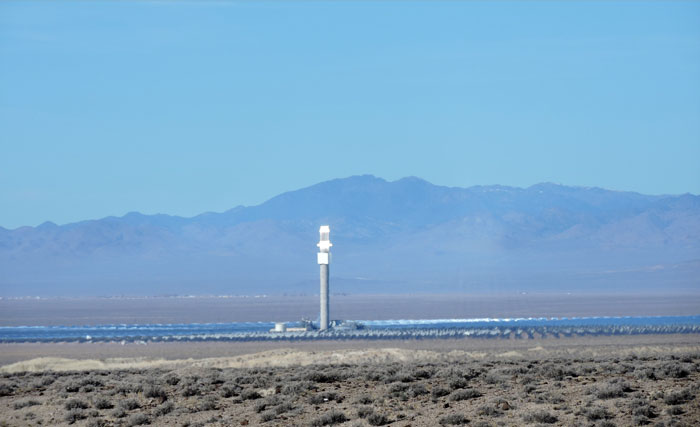
^Crescent Dunes solar power tower undergoing testing with a percentage of mirrors aimed at the tower receiver (not full), and other mirrors aimed at stand-by points near the tower, which can be seen visibly as slight whitish haze. This is the solar flux.
February 18, 2015 - Basin & Range Watch visited the Crescent Dunes solar power tower to observe testing on February 17 and we talked in person with Bureau of Land Management personnel in Tonopah to discuss a recent bird mortality event.
We learned that 130 waterbirds (although we have yet to see a purported video, other sources say they were passerines) were killed in the solar flux of the power tower during a four hour period on January 14, as the birds flew into the intense solar flux of a special test arrangement of mirrors above the tower receiver A January 2014 compliance report explains what biologists on the ground saw and reported to BLM, the species of bird is not yet clarified. During this survey, several biologists on the project site reported seeing the birds fly into the solar flux, "turn white, and vaporize." No remains were found. The solar field at a distance appears like a large lake in the basin as the mirrors reflect blue sky.
In addition, a raptor was seen flying around the concentrated solar flux, then leaving the area. It was possibly attracted by the flock of waterbirds according to our BLM contact.
During the same survey, two ravens were seen flying toward the solar flux, and one was reported by biologists to fly into the solar flux field, "turn white, and vaporize."
The flux at this tall project is hotter than the Ivanpah solar power towers because of the geometry of the heliostat array and taller power tower.
Solar flux is heat energy (kilowatts per square meter) transferred to an object, and not actually heated air. Testimony during the Hidden Hills Solar Electric Generating System project proceeding was very educational on this point.
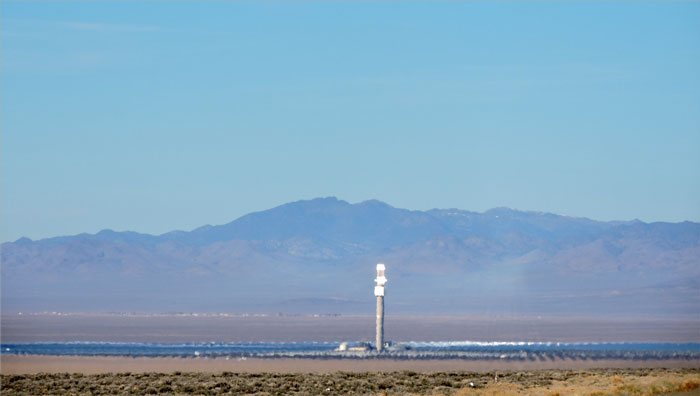
What apparently caused this bird kill was a different array of mirrors on stand by in a "halo" array, where a majority of mirrors were aimed above the tower in a halo shape of intense solar flux. This flux was so intense and hot that it surpassed normal solar flux, and was only used for testing purposes as mirrors were being aimed and aligned at the tower. The flock of birds haplessly flew into this super-intense flux and perished immediately.
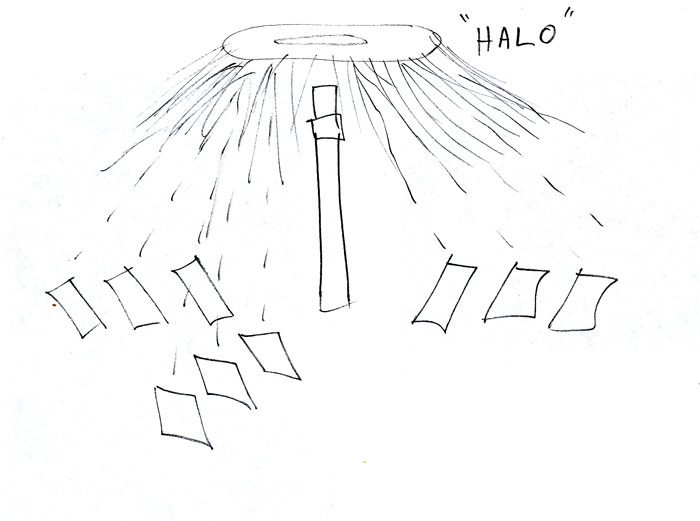
^Drawing of the "halo" solar flux created during certain testing phases which killed birds in January 2015, as illustrated to us by Tonopah BLM managers. During this test procedure, mirrors created the halo flux temporarily and then lowered the mirrors to aim the flux at the tower to produce eletricity. Yet even this was enough to accidentally kill birds.
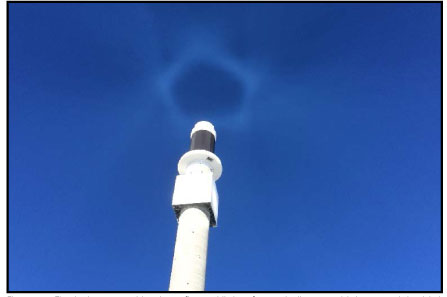
^"Halo" solar flux, from the January 2014 compliance report.
This test array was determined to be dangerous to birds and was changed to a different array, the "pancake" array, after engineers tried to mitigate testing by using geometries of mirrors that would not create such an intense solar flux.

^After the bird kill event, engineers redesigned the test solar flux to a "pancake" array to try to mitigate bird mortality. This design during testing would align mirrors to point to numerous spots above the tower that were more distant from each other than the halo, therefore creating a less intense solar flux that would theoretically not kill birds. Only time and scientific monitoring will tell if this design will mitigate bird deaths.
What has not been mitigated is what we believe to be the "lake effect" of the solar mirror field out in the desert basin which may be attracting birds to a perceived water feature, then luring them to their death in the solar flux. This solar flux will be intense during operation as well as during testing, as witnessed at the Ivanpah solar project.
BLM also pointed out to us that NV Energy was sending this energy mostly to mines to the east, toward central Nevada, and not houses. So large strip mines are the beneficiaries of this "green" energy.
During bird mortality monitoring surveys biologists found few other remains, only a wing of a bird in the solar field area. Future mitigation will include surveys outside the project boundary to determine what effects the solar power tower might be having on surrounding bird habitats.
Biologists found remains of a barn owl that had apparently collided with a heliostat in October 2014.
The solar thermal plant with molten salt storage will theoretically store enough heat energy to produce electricity 16 hours after sunset. We will be interested to see how this plays out in reality.
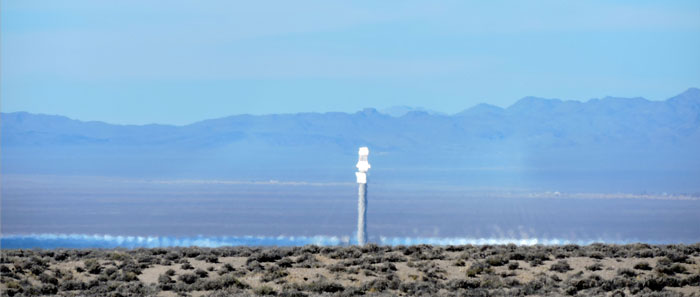
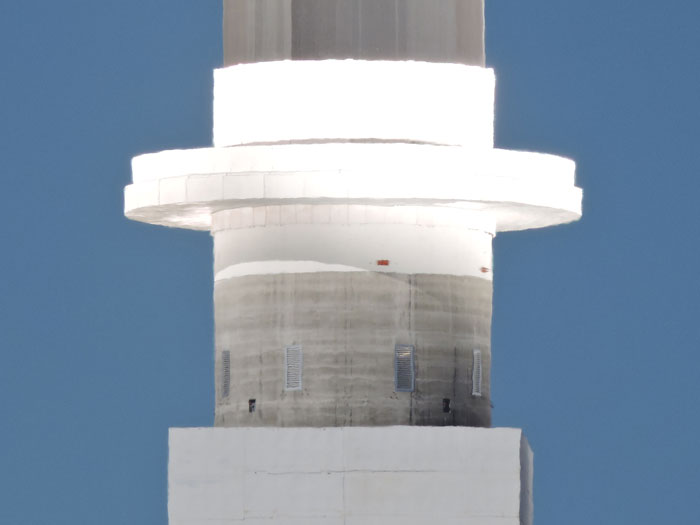
^During testing the tower receiver becomes white hot as mirrors aim intense solar flux at it. Birds similarly turn white hot and superheat to their deaths.
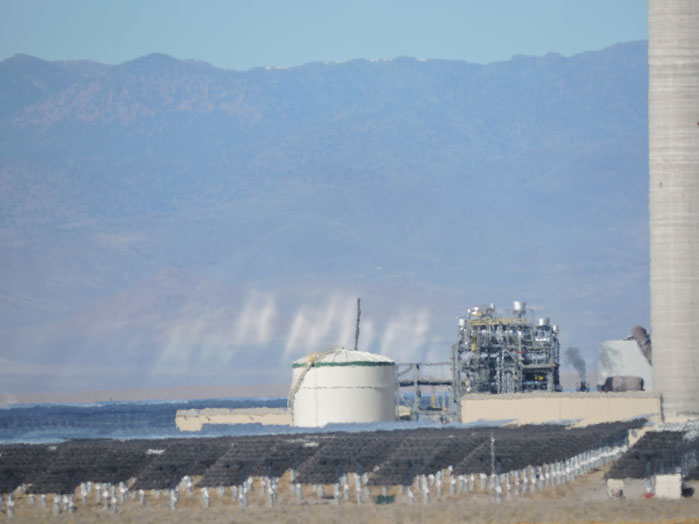
^Mirrors reflecting sunlight off of steam generated at the solar plant.
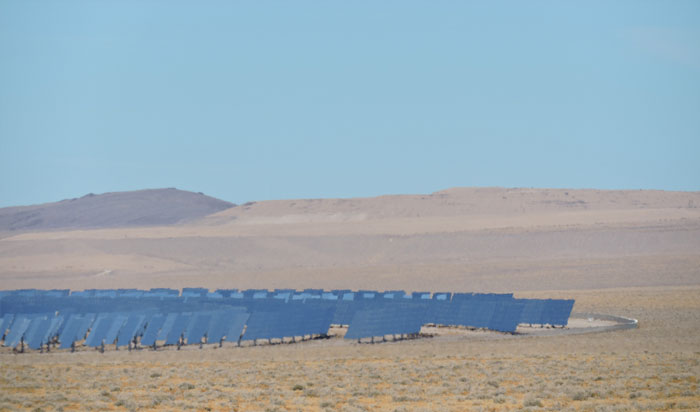
^The edge of the mirror field.

^Arc Dome peak in the Toiyabe Range visible in the distance from the power tower during testing.

^Large mirrors aimed at the tower. But they reflect blue sky and create a lake effect.
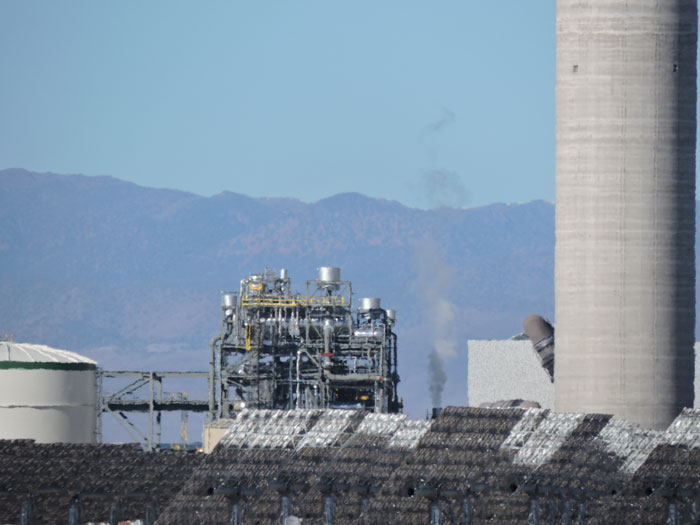
^Steam release during the project testing.
See also the KCET article.
Photos of the Power Tower
May 30, 2014 - Photos from April and May 2014, of the project nearing completion.
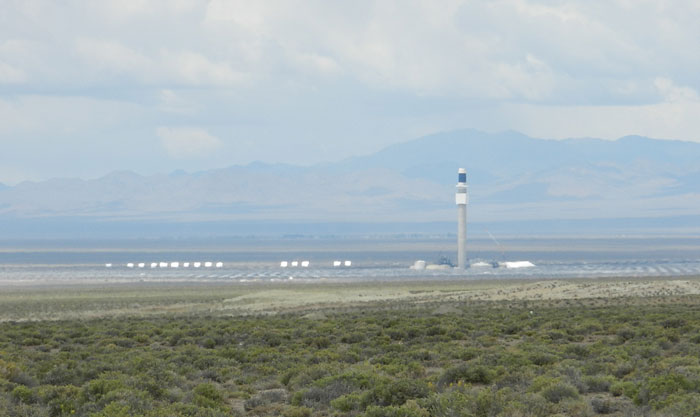
^Some mirrors angled and flashing glare in the sunlight.
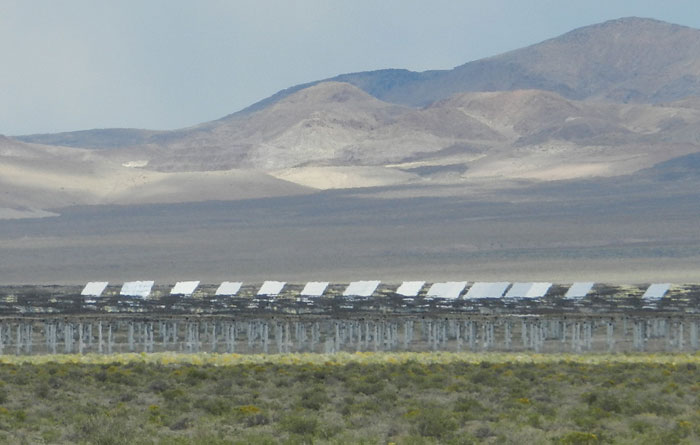
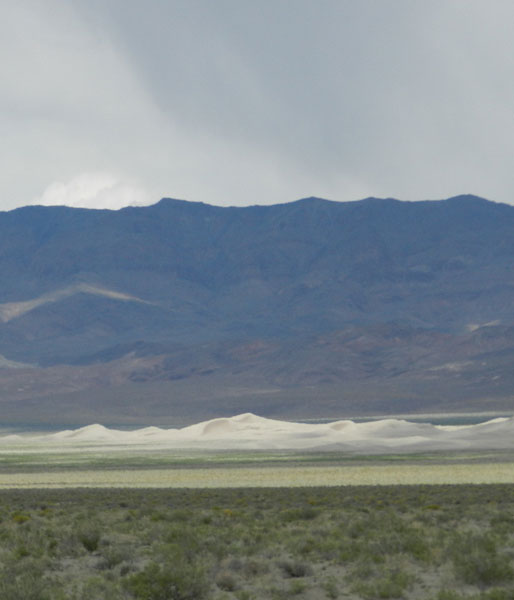
^Crescent Dunes adjacent to the project in May.
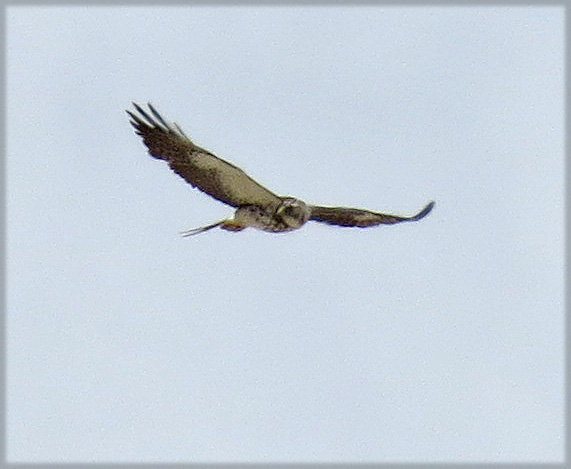
^A Swainson's hawk, light phase, was seen circling over the desert a few miles from the solar power tower project in May. A species of concern breeding in spots in Nevada, we hope this bird will not suffer mortality when the intense solar flux is activated during operation.
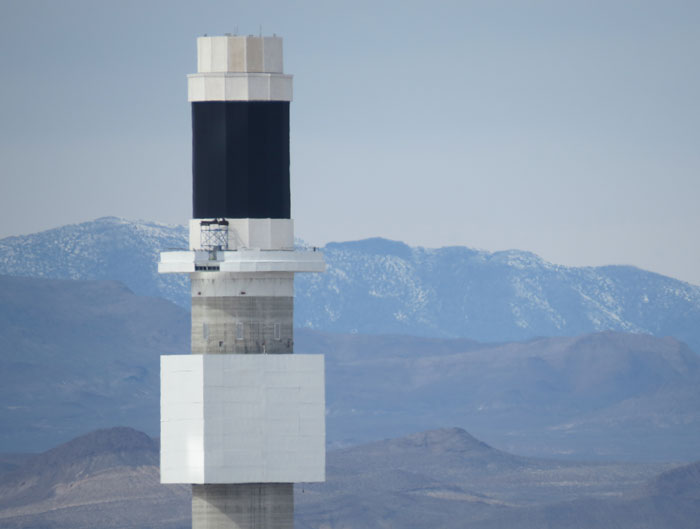
^Power tower receiver and target below it where mirrors aim solar flux to test.
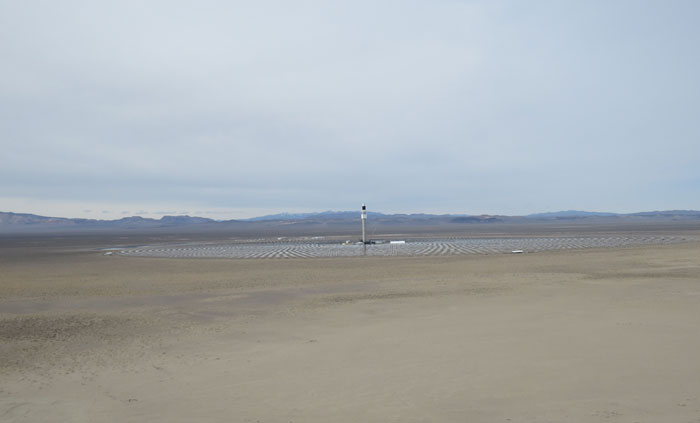
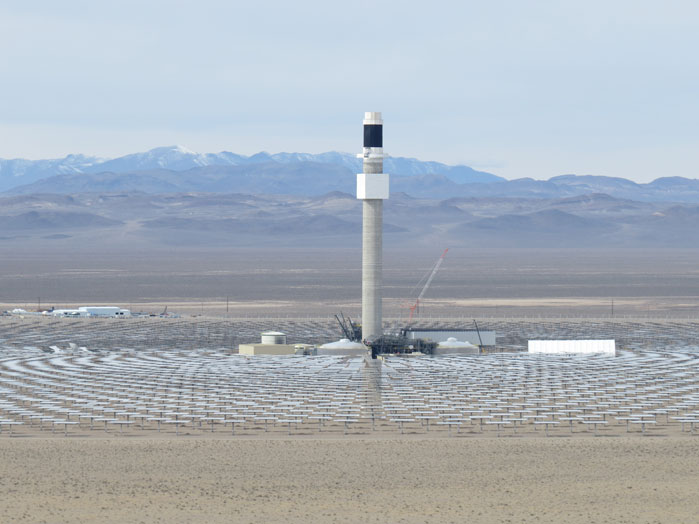
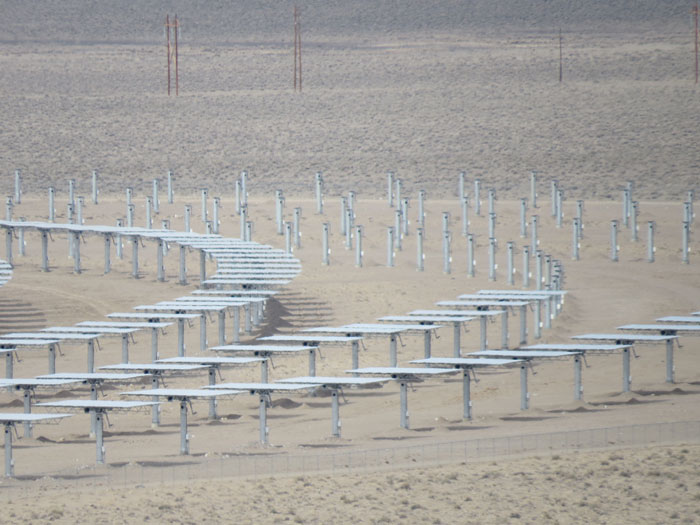
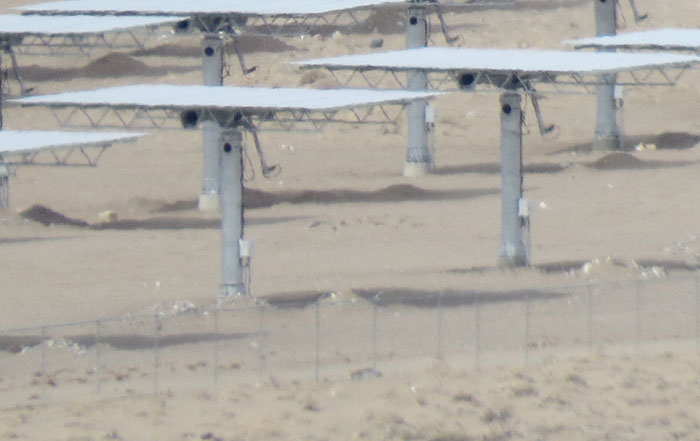
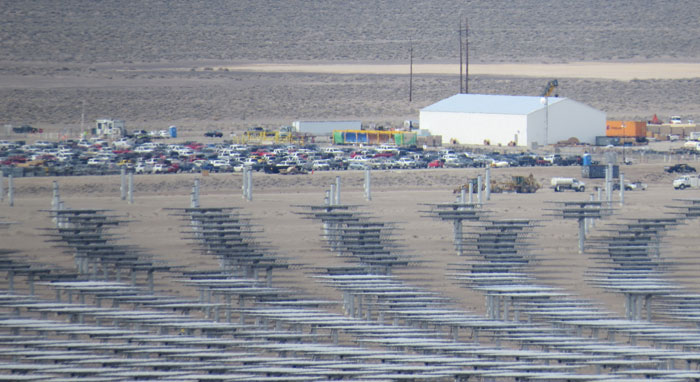
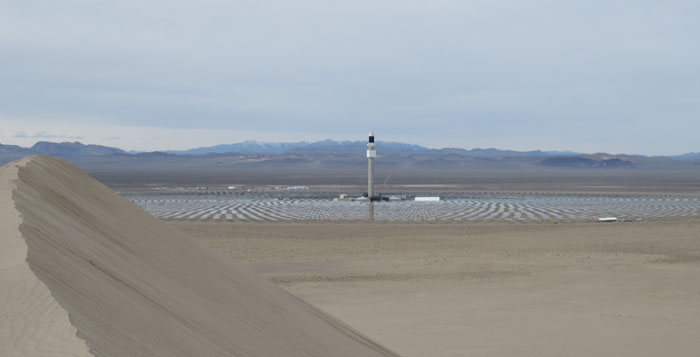
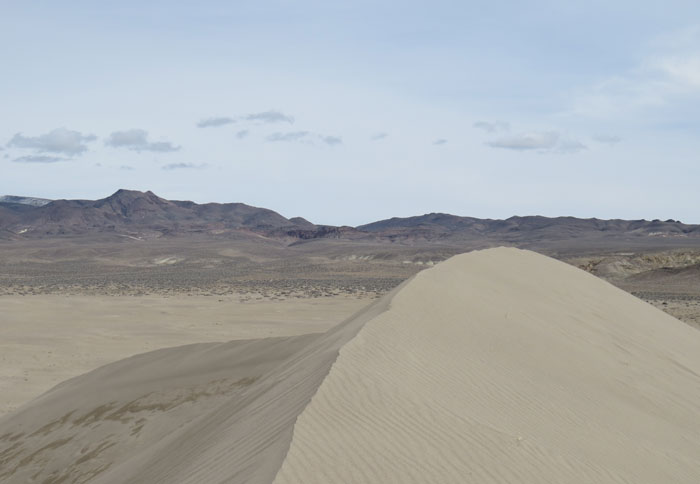
^Crescent Dunes in April.
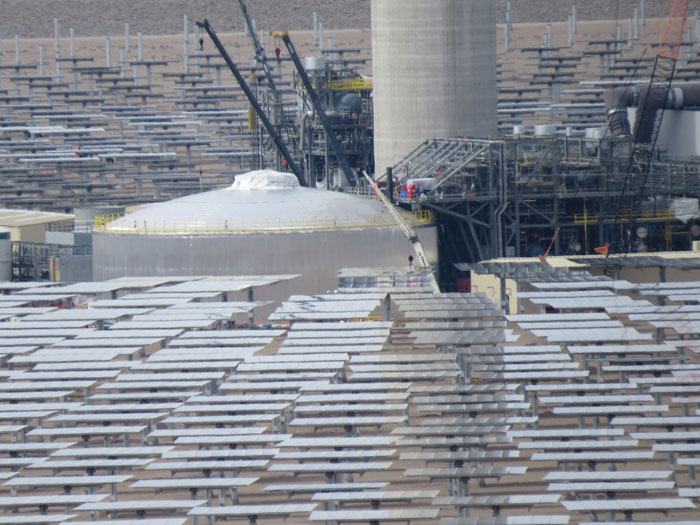
^Thermal salt storage tanks under construction.
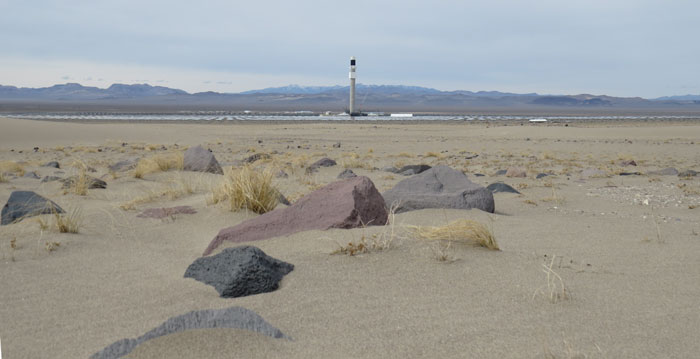
^Ventifacts in the desert next to the project. Rocks shaped by wind -- how will the mirrors fair in these harsh desert winds?
Construction Nearing Completion, Testing
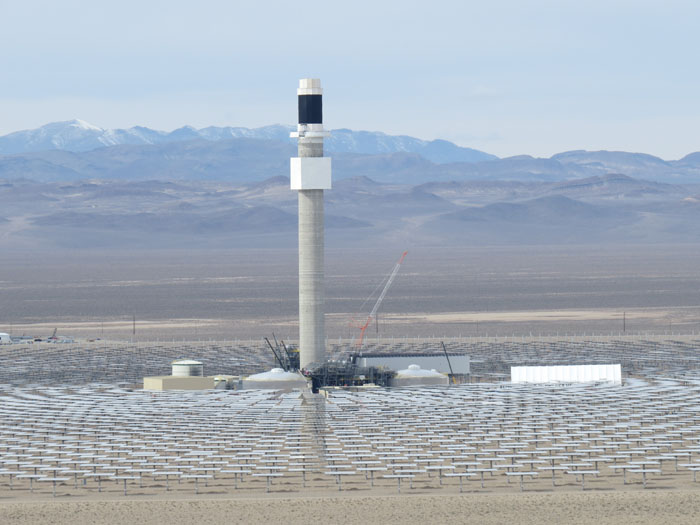
April 30, 2014 - Solar Reserve is now testing their Crescent Dunes Solar Project. This is a solar power tower built on public land near Tonopah, Nevada similar to the ones built in Ivanpah Valley, but incorporates molten salt thermal storage. They finished installing their heliostats (reflector mirrors) about a month ago. Now the heat is being aimed at the tower and the focus block beneath the receiver in tests. According to the Bureau of Land Management (BLM), there is “solar flux” happening there now during the tests. Solar flux is the concentrated heat around the tower that can be lethal to birds and insects in a 2,000 foot radius around the tower. The BLM has assured us that no dead birds have been found yet. While it may be true that none were found, it should be noted that the Avian and Bat Protection Plan for the Crescent Dunes Project does not require focused monitoring until after the project goes on line. The mirrors have been sitting flat for about one year. Birds also collide with mirrors that create the lake effect, but no monitoring has taken place in a year.
The project also has very large evaporation ponds and none of the agencies are requiring that they be covered. They say they will fire water cannons to scare birds away. Water attracts birds, birds die in solar flux. Large California solar projects do cover their evaporation ponds with netting.
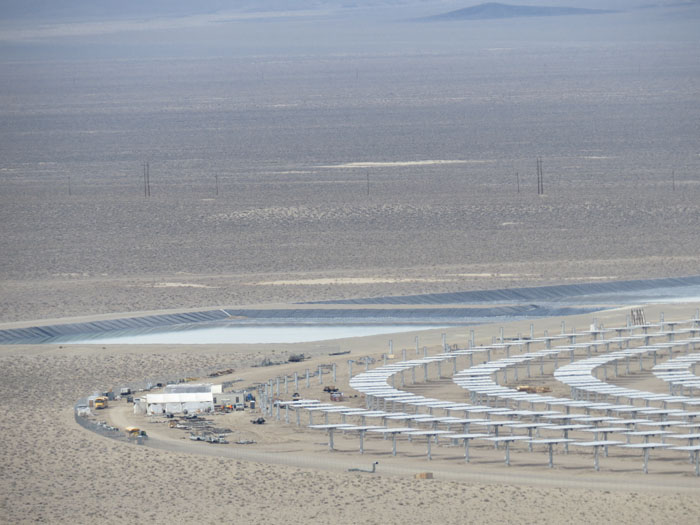
^Evaporation ponds beyond the solar field.
The Crescent Dunes are located near the Miller’s Rest Stop which is recognized as an important area for migratory birds. Now that the spring migration is about half way through, a variety of bird species are using the area. In spite of comments warning them about this problem during the review of the project, BLM mostly ignored the concerns. There is now great concern about the solar flux and both the Fish and Wildlife Service and the Nevada Division of Wildlife are meeting tomorrow to discuss the issue. No, it is not a public meeting. The BLM also approved a 16,000 acre solar energy zone surrounding the entire area, but little transmission exists.
Solar Reserve Power Tower Construction Continues
August 26, 2012 - The large-scale solar thermal project near Tonopah, Nevada has been delayed at times, and these photos show current construction in mid August. No heliostats are up yet, and the tower has another 100 feet to go. The operations and maintenance building is also under construction, and mirrors will be built inside and then placed in the solar fields.
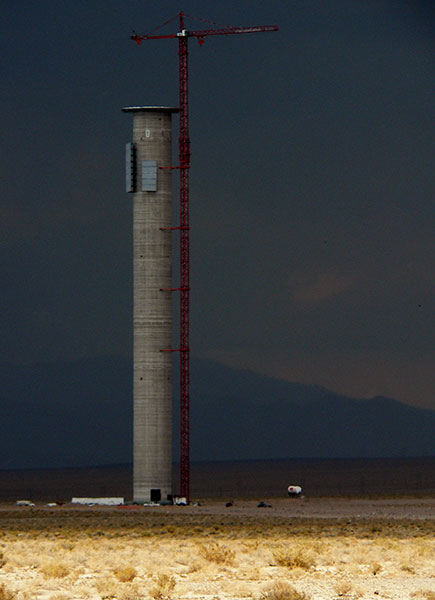
^Power tower under construction in stormy weather (photo by Wayne Bundorf).
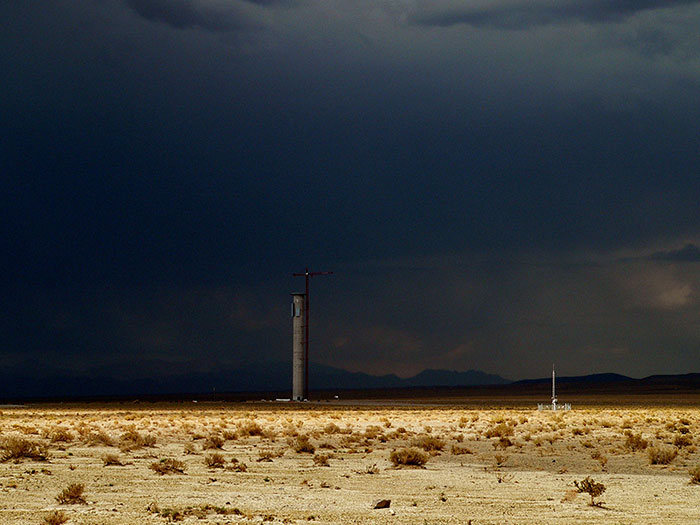
^ (Photo by Wayne Bundorf).
Dune Beetles Found to be in Peril
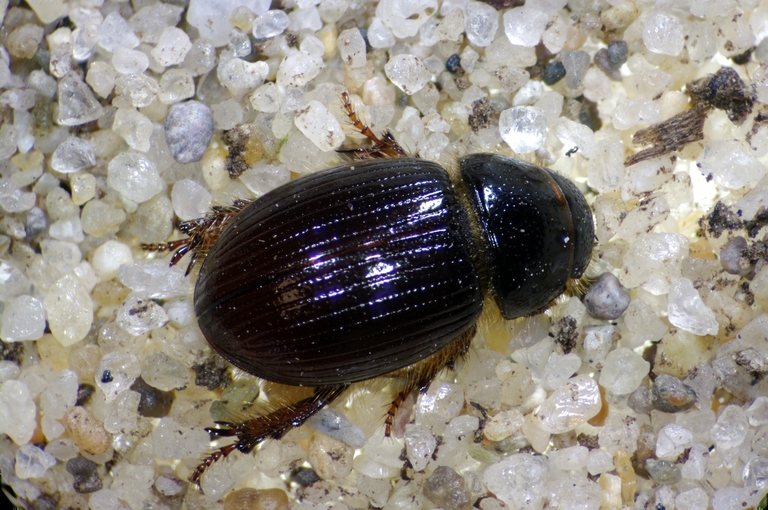
^Crescent Dunes Aegialian Scarab (Aegialia crescenta), © 2012 Janel Johnson (http://calphotos.berkeley.edu/cgi/img_query?enlarge=0000+0000+0212+0151).
July 18, 2012 - 12- US Fish and Wildlife Service issued a 12-month finding today on a petition to list six Nevada sand dune beetles as Endangered or Threatened under the federal Endangered Species Act. Critical habitat would be designated.
During the FWS 90-day finding, substantial information was found to indicate four of the six species may be warranted for listing, including Crescent Dunes aegialian scarab (Aegialia crescenta), Crescent Dunes serican scarab (Serica ammomenisco), large aegialian scarab (Aegialia magnifica), as well as the Giuliani's dune scarab (Pseudocotalpa giulianii).
Two species were not found warranted for listing: Hardy's aegialian scarab (Aegialia hardyi) and Sand Mountain serican scarab (Serica psammobunus).
Fish and Wildlife Service will now undertake a status review of each of the four species to determine if listing should be done. The public is encouraged to submit comments.
Solar development was mentioned as one of the threats to the dune beetles: "Developing land for solar energy projects on or near the dunes may compact and remove both vegetation and sand, alter surface flows and infiltration of water, and affect temperature and wind patterns. Destruction of vegetation around dunes, disturbance of dune sand, and disruption of reproductive behavior would reduce or eliminate sand dune
beetle populations because the larvae of the four beetle species use decomposed organic matter as their primary food source and the adults mate on live vegetation. In addition, sand transport processes and other ecological processes that create habitat for these four species of sand dune beetles may be altered by structures blocking the wind
Roads and increased human presence associated with solar development result in indirect effects to dune beetles (e.g., roads and increased human presence may result in increased illegal ORV use, which impacts beetle habitat)."
The Crescent Dunes Solar Energy Project under construction is 1,619 acres and is located within the range of the Crescent Dunes aegialian scarab and Crescent Dunes serican scarab. Construction will remove approximately 1,500 acres or 2.3 sq miles, which is 10 percent of the total range of the Crescent Dunes aegialian scarab and 11 percent of the total range of the Crescent Dunes serican scarab. This is an unacceptably large chunk of habitat destruction for beetles that live no where else on the planet. This information was not available in the Final Environmental Impact Statement issued by the Bureau of Land Management. Only in 2012, after construction started, were surveyscarried out to determine the status of the beetle species.
It is unlikely that the Crescent Dunes Solar Energy Project will disrupt sand transport processes at Crescent Dunes because the facility will not block the prevailing winds.
FWS notes that the proposed Miller's Solar Energy Zone 5 miles to the southwest of Crescent Dunes would apparently not impact the dune beetles' range or sand flow. But we question whether indirect effects would further endanger the beetles from cumulative industrial development in the region. This needs to be fully analyzed before more renewable energy projects are approved.
Since 2007, there have been five Right Of Way applications for solar development at Big Dune and none at Lava Dune, with all inactive currently. Solar development projects near Big Dune or Lava Dune could threaten the large aegialian scarab or Giuliani's dune scarab.
Mining and off-road activity are other potential threats to these sand beetles. Little is known about the biology of these beetles, but FWS acknowledges that climate change may impact the dune vegetation that the beetles depend on.
The petition was received on January 29, 2010 from WildEarth Guardians. Most environmental groups unfortunately did nothing to speak up, or protect or preserve these species and their habitat when these issues were brought up. We thank WildEarth Guardians for carrying this petition forward. We have talked at length about these unique beetles and their dune habitats with the late Derham Giuliani, who feared the destruction of these areas would be ongoing.
See http://www.gpo.gov/fdsys/search/getfrtoc.action, scroll down to Fish and Wildlife Service, download the PDF file or view text.
Power Tower Construction Under Way
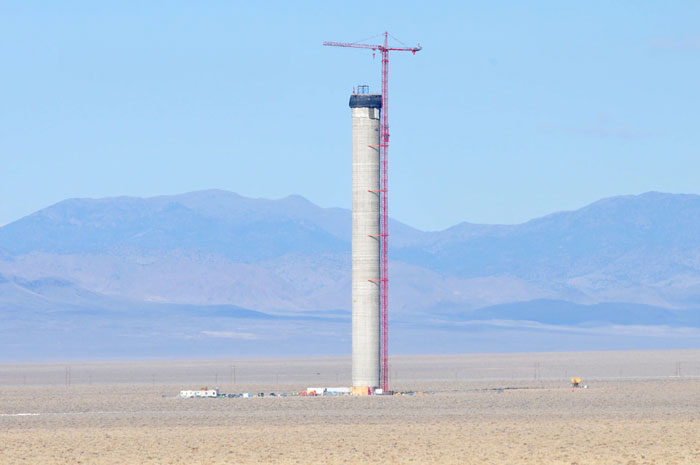
December 20, 2011 - Solar Reserve has begun construction of the 600-foot solar thermal power tower in the middle of a broad basin northwest of Tonopah, Nevada. It dominates the landscape now, much taller than the nearby Crescent Dunes.
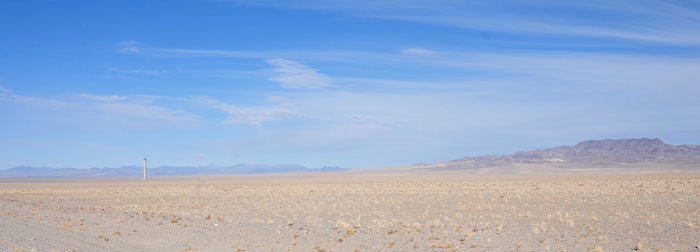
^The tower is the only tall structure in the landscape.
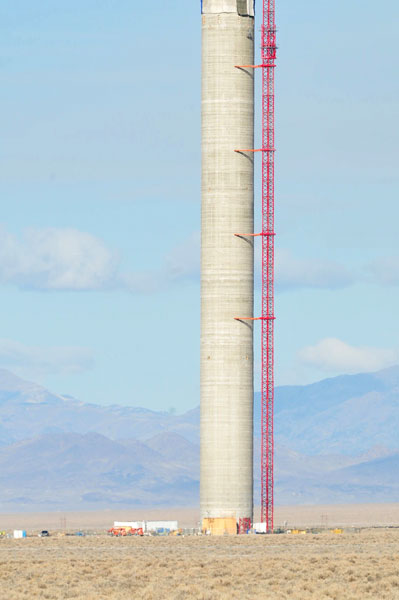
^Cement power tower that will be surrounded by mirrors.

^Sandy desert basin habitat surrounds the project.
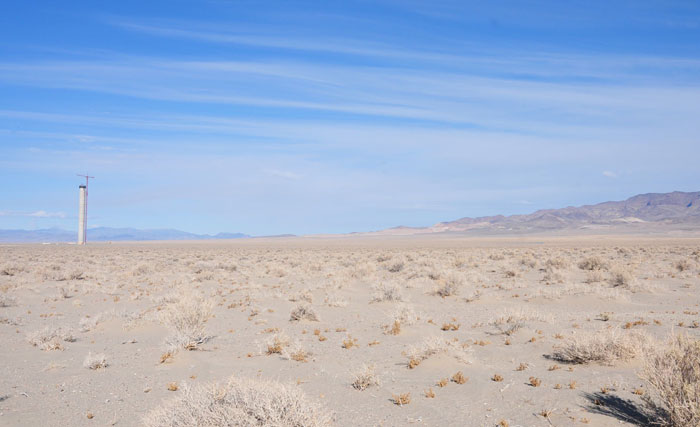
^Shrub desert around the project.
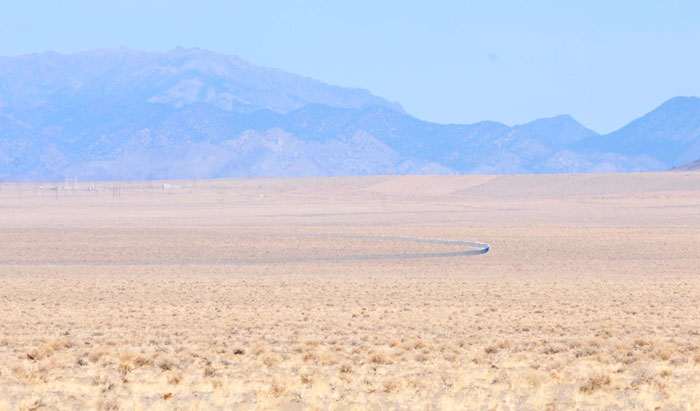
^A chainlink fence surrounds the future circular solar field, not yet constructed.
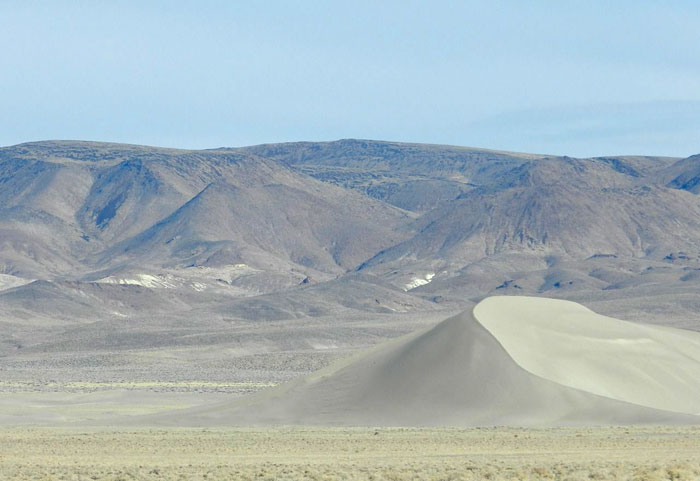
^Crescent Dunes a few miles away from the project site.
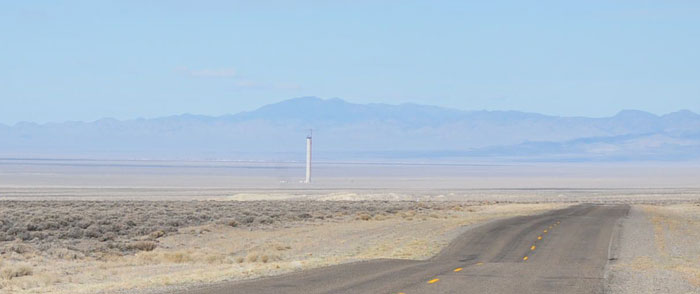
^The power tower visible from a small road heading north from Highway 95.

^Distant power tower from a county road.

^The Toiyabe Range lies in the distance.
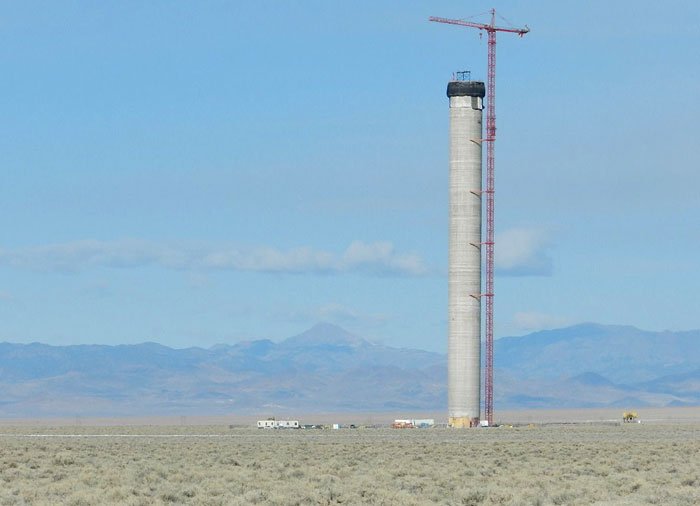
^Arc Dome in the Toiyabe Range, about 40 miles distant, can be seen to the left of the tower. Arc Dome is in a wilderness area.
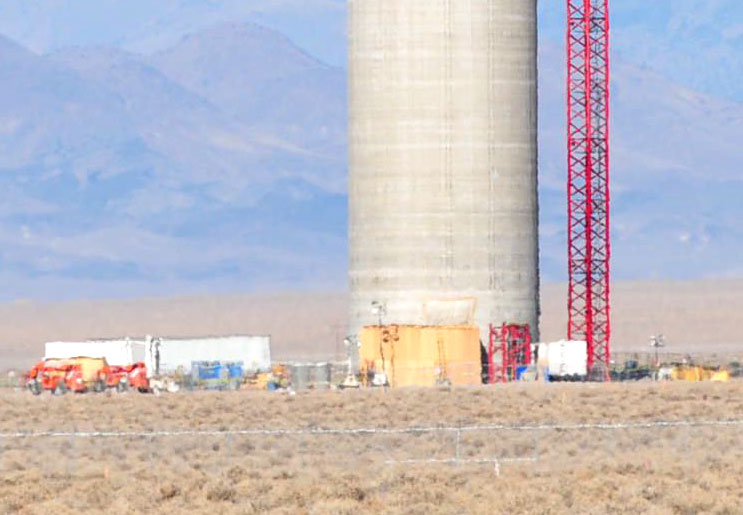
^Base of the power tower.
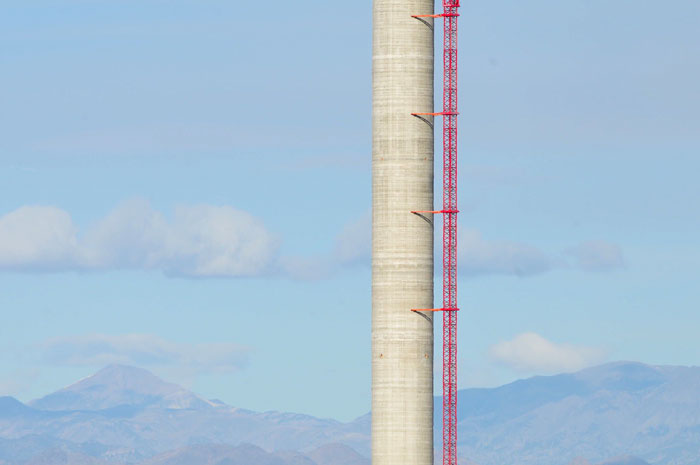
^Arc Dome peak rises in the distance at 11,361 feet.

^Top of the power tower.
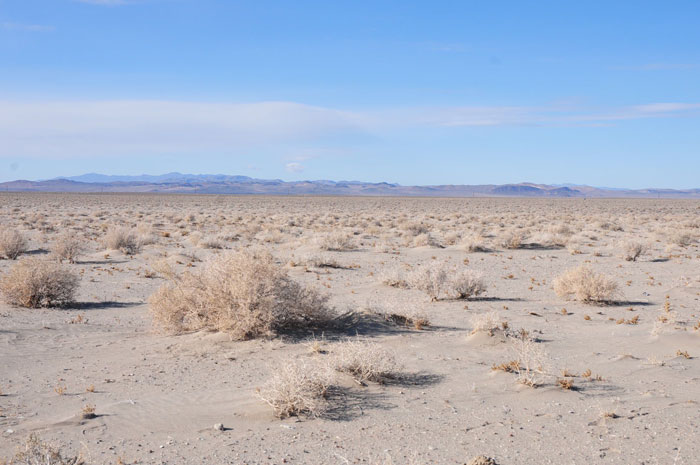
^Near the power tower, looking westwards towards the Miller's Solar Energy Zone proposed by Bureau of Land Management in its solar Programmatic Environmental Impact Statement.
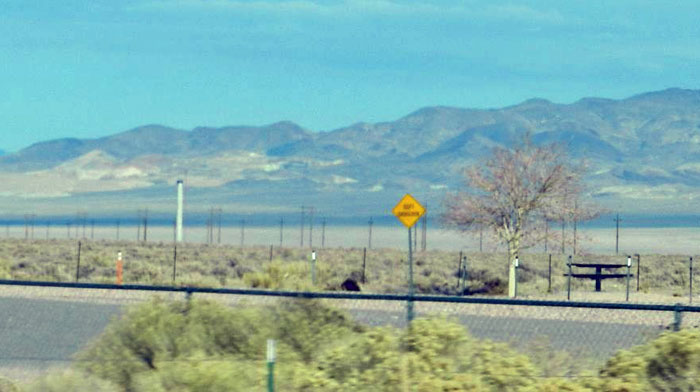
^The Solar Reserve power tower (left) visible from Miller's Rest Stop along Highway 95, an important birdwatching area where migratory songbirds are attracted to the small oasis in spring and fall.
DOE Awards Loan Guarantee to Crescent Dunes Project
September 28, 2011 - With the deadline looming on September 30 for the program to end, Solar Reserve squeaked under the wire to receive a $737 million Department of Energy loan guarantee. The 110 megawatt concentrating solar power tower generating facility with molten salt as the primary heat transfer and storage medium. It will be the first of its kind in the United States and the tallest molten salt tower in the world. Located 14 miles northwest of Tonopah, Nevada on land leased from the Bureau of Land Management, the company anticipates the facility will fund 600 construction jobs and 45 permanent jobs. The Crescent Dunes Solar Energy facility is expected to avoid nearly 290,000 metric tons of carbon dioxide annually.
The project includes 17,500 heliostats (mirror assemblies) that collect and focus the sun's thermal energy to heat molten salt flowing through an approximately 640-foot tall solar power tower. The high temperature molten salt circulates from the tower to a storage tank, where it is then used to produce steam and generate electricity. Excess thermal energy is stored in the molten salt for about 6 hours after sunset. The molten salt is not explosive, and any leaks would solidify.
Financing on the Edge
September 23, 2011 - Even with ground broken on the power block, according to Pahrump Valley Times, Solar Reserve needs Nye County to resolve a snag in the Development Agreement concerning the Bureau of Land Management Right-of-Way connecting the project to NV Energy's Anaconda Moly substation. NV Energy already signed a 25-year power purchase agreement with SolarReserve.
The U.S. Department of Energy made conditional a $737 million loan guarantee for the project last April. By Wednesday DOE must close the loan to finalize it, before the September 30 deadline, or Solar Reserve risks losing it.
http://pvtimes.com/news/solar-reserve-pact-changed/
Salazar Approves Project
December 20, 2010 - Seemingly before the end of the public comment period, Interior Secretary Ken Salazar signed the approval of Crescent Dunes Solar Energy Project, enabling the company to begin construction.
The project, proposed by SolarReserve's Tonopah Solar Energy, LLC of Santa Monica, California, is sited on approximately 2,250 acres administered by the Bureau of Land Management (BLM) about 13 miles northwest of Tonopah in Nye County, Nevada.
“These energy projects exemplify the collaborative partnerships we have developed to help achieve our common goals to protect our natural environment while utilizing America’s wealth of renewable energy resources,” said Bureau of Land Management Director Bob Abbey.
Draft Environmental Impact Statement Out
September 3, 2010 - Notice of Availability of Draft Environmental Impact Statement for the Tonopah Solar Energy Crescent Dunes Solar Energy Project, Nye County, NV, by Bureau of Land Management.
SUMMARY: In accordance with the National Environmental Policy Act of 1969, as amended (NEPA), the Bureau of Land Management (BLM) has prepared a Draft Environmental Impact Statement (EIS) for the Crescent Dunes Solar Energy Project, Nye County, Nevada, and by this Notice is announcing the opening of the comment period.
DATES: To ensure comments will be considered, the BLM must receive written comments on the Crescent Dunes Solar Energy Project Draft EIS within 45 days following the date the Environmental Protection Agency publishes its Notice of Availability in the Federal Register. The BLM will announce future meetings or hearings and any other public
involvement activities at least 15 days in advance through public notices, media news releases, and/or mailings.
ADDRESSES: You may submit comments on the Crescent Dunes Solar Energy Project Draft EIS by any of the following methods:
E-mail: crescent_dunes@blm.gov.
Fax: 775-482-7810.
Mail: Timothy Coward, Renewable Energy Project Manager, BLM Tonopah Field Office, P.O. Box 911, Tonopah, Nevada 89049.
Copies of the Draft EIS for the Crescent Dunes Solar Energy Project are available at the BLM Tonopah Field Office and at the Battle Mountain District Office, 50 Bastian Road, Battle Mountain, Nevada, or at the following Web site: http://www.blm.gov/nv/st/en/fo/battle_mountain_field.html.
FOR FURTHER INFORMATION CONTACT: Timothy Coward, (775) 482-7800, BLM Tonopah Field Office, 1553 South Main Street, P.O. Box 911, Tonopah, Nevada 89049; Timothy_Coward@blm.gov.
SUPPLEMENTARY INFORMATION: Tonopah Solar Energy, LLC applied to the BLM for a 7,680-acre right-of-way (ROW) on public lands to construct a concentrated solar thermal power plant facility approximately 13 miles northwest of Tonopah, Nye County, Nevada. The proposed project is not expected to use the total acres applied for in the ROW application. The project is located within the southern portion of the Big Smoky Valley,
north of U.S. Highway 95/6 along the Gabbs Pole Line Road (State Highway 89). The facility is expected to operate for approximately 30 years. The proposed solar power project would use concentrated solar power technology, using heliostats or mirrors to focus sunlight on a receiver erected in the center of the solar field (the power tower or central receiver). A heat transfer fluid is heated as it passes through the receiver and is then circulated through a series of heat exchangers to generate high-pressure steam. The steam is used to power a conventional Rankine cycle steam turbine, which produces electricity. The exhaust steam from the turbine is condensed and returned via
feedwater pumps to the heat exchangers where steam is regenerated. Hybrid cooling processes would be used for this project to minimize water use while continuing to maintain efficient power generation. The plant design would generate a nominal capacity of 100 megawatts.
The project's proposed facility design includes the heliostat fields, a 653-foot central receiver tower, a power block, buildings, a parking area, a laydown area, evaporating ponds, and an access road. A single overhead 230-kilovolt transmission line would connect the plant to the nearby Anaconda Moly substation. The Draft EIS describes and analyzes the proposed project's site-specific impacts on air quality, biological resources, cultural resources, water resources, geological resources, hazardous materials handling, land use, noise, paleontological resources, public health, socioeconomics, soils, traffic and transportation, visual resources, wilderness characteristics, waste management, worker safety, and fire protection. The Draft EIS also describes facility design engineering, efficiency, reliability, transmission system engineering, and transmission line safety.
Three action alternatives were analyzed in addition to the No Action alternative: the Proposed Action Alternative, Alternative 1, and Alternative 2. Alternative 2 is the BLM preferred alternative. Scoping of the project occurred from November 24, 2009 through
December 24, 2009. A total of 24 comments were received. Comments on cumulative impacts identified the affects to air quality to include criteria pollutant and "Dark Sky'' attributes on the effects of the viewshed, and the availability of water for current and future use. Other comments were that the proposed project is located in an area of
pediment adjacent to 2 highly mineralized mountain ranges which have identified molybdenum and lithium deposits. Maps of the proposed project area and the alternatives being analyzed in the Draft EIS are available at the BLM Tonopah Field Office, the Battle Mountain District Office, and at: http://www.blm.gov/nv/st/en/fo/battle_mountain_field.html.
Please note that public comments and information submitted, including names, street addresses, and e-mail addresses of persons who submit comments, will be available for public review and disclosure at the above address during regular business hours (8 a.m. to 4 p.m.), Monday through Friday, except holidays. Before including your address, phone number, e-mail address, or other personal identifying information in your comment, you should be aware that your entire comment--including your personal identifying information--may be made publicly available at any time. While you can ask us in your comment to withhold your personal identifying information from public review, we cannot
guarantee that we will be able to do so.
[Federal Register: September 3, 2010 (Volume 75, Number 171)]
[Notices]
[Page 54177]
From the Federal Register Online via GPO Access [wais.access.gpo.gov]
[DOCID:fr03se10-92]
^Crescent Dunes in Big Smoky Valley, Nye County, Nevada.
Solar Thermal Power Tower Proposal
July 28, 2010 - Tonopah, Nevada - SolarReserve, a California-based developer of utility-scale solar power projects, begins next steps on its 100-megawatt Crescent Dunes Solar Energy Project in conjunction with NV Energy's receipt of approval from the Public Utilities Commission of Nevada (PUCN) today. This approval follows on last December's announcement that SolarReserve's wholly owned subsidiary, Tonopah Solar Energy LLC, and NV Energy had signed a 25-year power purchase agreement for the sale of electricity from the proposed 180 megawatt solar energy project located near the town of Tonopah, in Nye County, Nevada. The project would occupy 1,600 to 2,000 acres. Molten salt storage requires more water use for cooling than non-storage projects, and may be well over 500 acre-feet/year.
Utilizing an advanced molten salt system technology, the Crescent Dunes Solar Energy Project would be able to store 10 hours of solar energy and consequently would have the capacity to generate electricity during cloud cover or after the sun has gone down as well as the ability to shift power production to meet peak demand periods. When completed, the Crescent Dunes solar project will supply approximately 480,000 megawatt hours annually of electricity.
Electricity from Crescent Dunes would go into the power grid that serves Northern Nevada. But after NV Energy finishes its 235-mile One Nevada transmission network, possibly by mid-2012, then north and south grids will connect, and energy from Crescent Dunes will power homes in the Las Vegas Valley.
The project still needs to go through the Bureau of Land Management environmental review process, and even though it is Fast-tracked, we have not seen a Draft Environmental Impact Statement appear yet.
See Market Watch and Las Vegas Review-Journal.
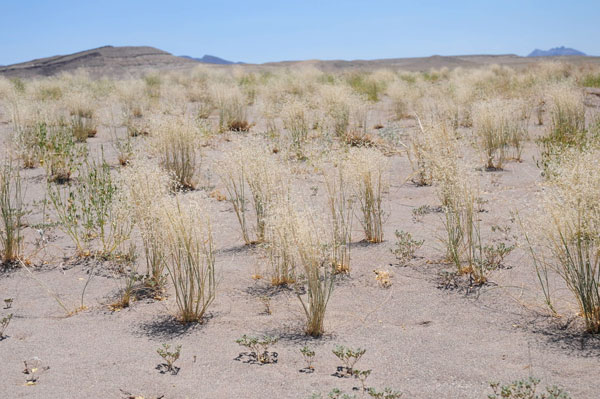
^Indian rice grass (Achnatherum hymenoides) forms a luxuriant desert grassland on the sand sheet next to the tall dunes where SolarReserve wants to construct its power tower.
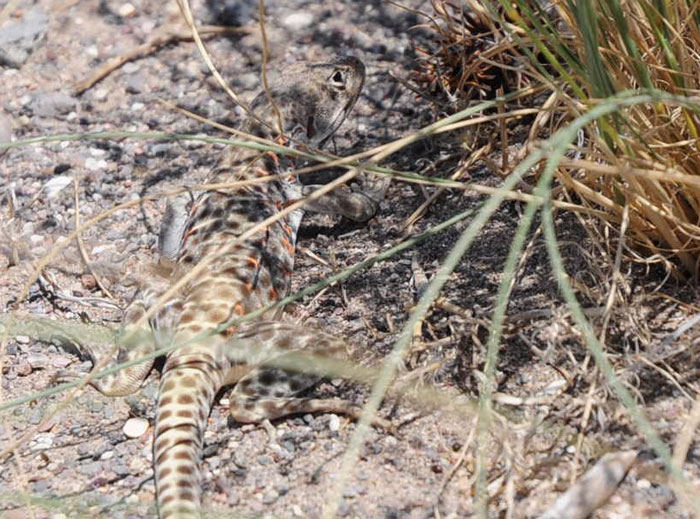
^A female Long-nosed leopard lizard (Gambelia wilizenii) takes a shade break under an Indian ricegrass bunch while out hunting for smaller lizards on the site.
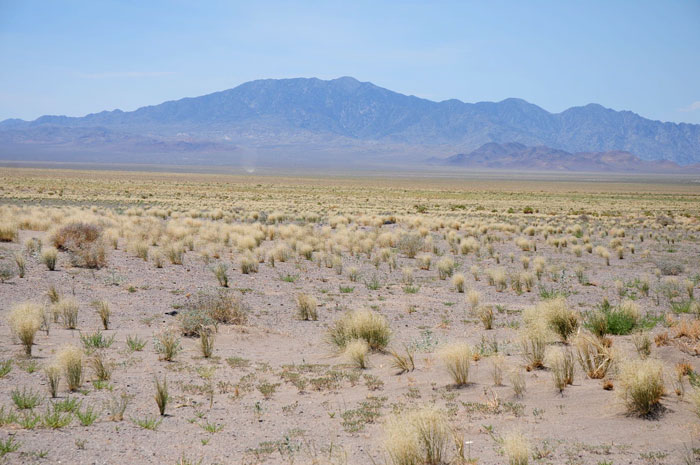
^The project site north of Tonopah, Nevada, with Lone Mountain, an ancient volcanic core from the Age of Dinosaurs, in the distance.
Other SolarReserve Projects
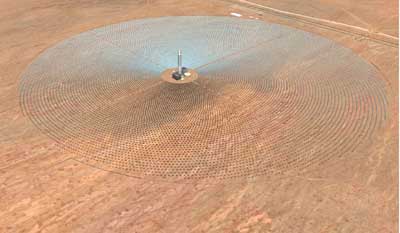
In California, the SolarReserve's Rice Solar Energy Project would produce 150 MW on BLM land in Riverside County in remote Rice Valley, south of Ward Valley, the Turtle Mountains, and Vidal Junction. See the California Energy Commission website.
Residents of the San Luis Valley in Saguache County, Colorado, became aware of a similar 200 MW project recently, north of Center on about 6,500 acres of private land. Two 656-foot power towers would be surrounded by 25-foot high tracking mirrors. This project would also have molten salt tanks. Each plant would require 1,000 acre feet per year of water. See San Luis Valley Renewable Communities Alliance.

^Solar 1 at Daggett, California, where molten salt storage was tested in the 1990s. This plant has since closed and been dismantled.
